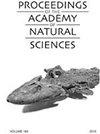Deciphering the many maps of the Xingu River Basin – an assessment of land cover classifications at multiple scales
IF 0.5
4区 环境科学与生态学
Q4 BIODIVERSITY CONSERVATION
Proceedings of the Academy of Natural Sciences of Philadelphia
Pub Date : 2020-11-24
DOI:10.1635/053.166.0118
引用次数: 4
Abstract
ABSTRACT. Remote sensing is an invaluable tool to objectively illustrate the rapid decline in habitat extents worldwide. The many operational Earth Observation platforms provide options for the generation of land cover maps, each with unique characteristics and considerable semantic differences in the definition of classes. As a result, differences in baseline estimates are inevitable. Here we compare forest cover and surface water estimates over four time periods spanning three decades (1989–2018) for ∼1.3 million km2 encompassing the Xingu River Basin, Brazil, from published, freely accessible remotely sensed land cover classifications. While all showed a decrease in forest extent over time, the total deforested area reported by each ranged widely for all time periods. The greatest differences ranged from 9% to 17% (116,958 to 219,778 km2) deforestation of the total area for year 2000 and 2014–2018 time period, respectively. We also show the high sensitivity of forest fragmentation metrics (entropy and foreground area density) to data quality and spatial resolution, with cloud cover and sensor artefacts resulting in errors. Surface water classifications must be chosen carefully because sources differ greatly in location and mapped area of surface water. After operationalization of the Belo Monte dam complex, the large reservoirs are notably absent from several of the classifications illustrating land cover. Freshwater ecosystem health is influenced by the land cover surrounding water bodies (e.g., riparian zones). Understanding differences between the many remotely sensed baselines is fundamentally important to avoid information misuse, and to objectively choose the most appropriate classification for ecological studies, conservation, or policy making. The differences between the classifications examined here are not a failure of the technology, but due to different interpretations of ‘forest cover’ and characteristics of the input data (e.g., spatial resolution). Our findings demonstrate the importance of transparency in the generation of remotely sensed classifications and the need for users to familiarize themselves with the characteristics and limitations of each data set.解读新谷河流域的多幅地图——多尺度土地覆盖分类的评估
摘要。遥感是客观说明全球栖息地范围迅速下降的宝贵工具。许多运行中的地球观测平台为生成土地覆盖图提供了选择,每一个平台都具有独特的特征,在类别定义方面存在相当大的语义差异。因此,基线估计数的差异是不可避免的。在这里,我们比较了巴西新谷河流域约130万平方公里的四个时间段(1989年至2018年)的森林覆盖率和地表水估计值,这些数据来自已公布的、可自由获取的遥感土地覆盖分类。虽然所有国家的森林面积都随着时间的推移而减少,但每个国家报告的总森林砍伐面积在所有时间段内变化很大。2000年和2014-2018年期间,最大的差异分别为总面积的9%至17%(116958至219778平方公里)。我们还展示了森林破碎化指标(熵和前景区域密度)对数据质量和空间分辨率的高度敏感性,云层覆盖和传感器伪影会导致误差。必须仔细选择地表水分类,因为地表水的来源在位置和地图面积上差异很大。Belo Monte大坝综合体投入运行后,大型水库明显没有出现在几个说明土地覆盖的分类中。淡水生态系统健康受到水体周围土地覆盖的影响(例如河岸带)。了解许多遥感基线之间的差异对于避免信息滥用以及客观地为生态研究、保护或政策制定选择最合适的分类至关重要。这里检查的分类之间的差异并不是技术的失败,而是由于对“森林覆盖率”和输入数据特征(如空间分辨率)的不同解释。我们的研究结果表明,透明度在生成遥感分类中的重要性,以及用户熟悉每个数据集的特征和局限性的必要性。
本文章由计算机程序翻译,如有差异,请以英文原文为准。
求助全文
约1分钟内获得全文
求助全文
来源期刊

Proceedings of the Academy of Natural Sciences of Philadelphia
生物多样性保护-生物多样性保护
自引率
0.00%
发文量
4
期刊介绍:
The Proceedings (ISSN 0097-3157) has been published continuously since 1841. Many volumes are still available in their original printings. Early volumes are unbound, constituting two or three issues per year. Quantities of some volumes may be limited. Early volumes may have slightly soiled cover sheets, but the text blocks are perfect.
 求助内容:
求助内容: 应助结果提醒方式:
应助结果提醒方式:


